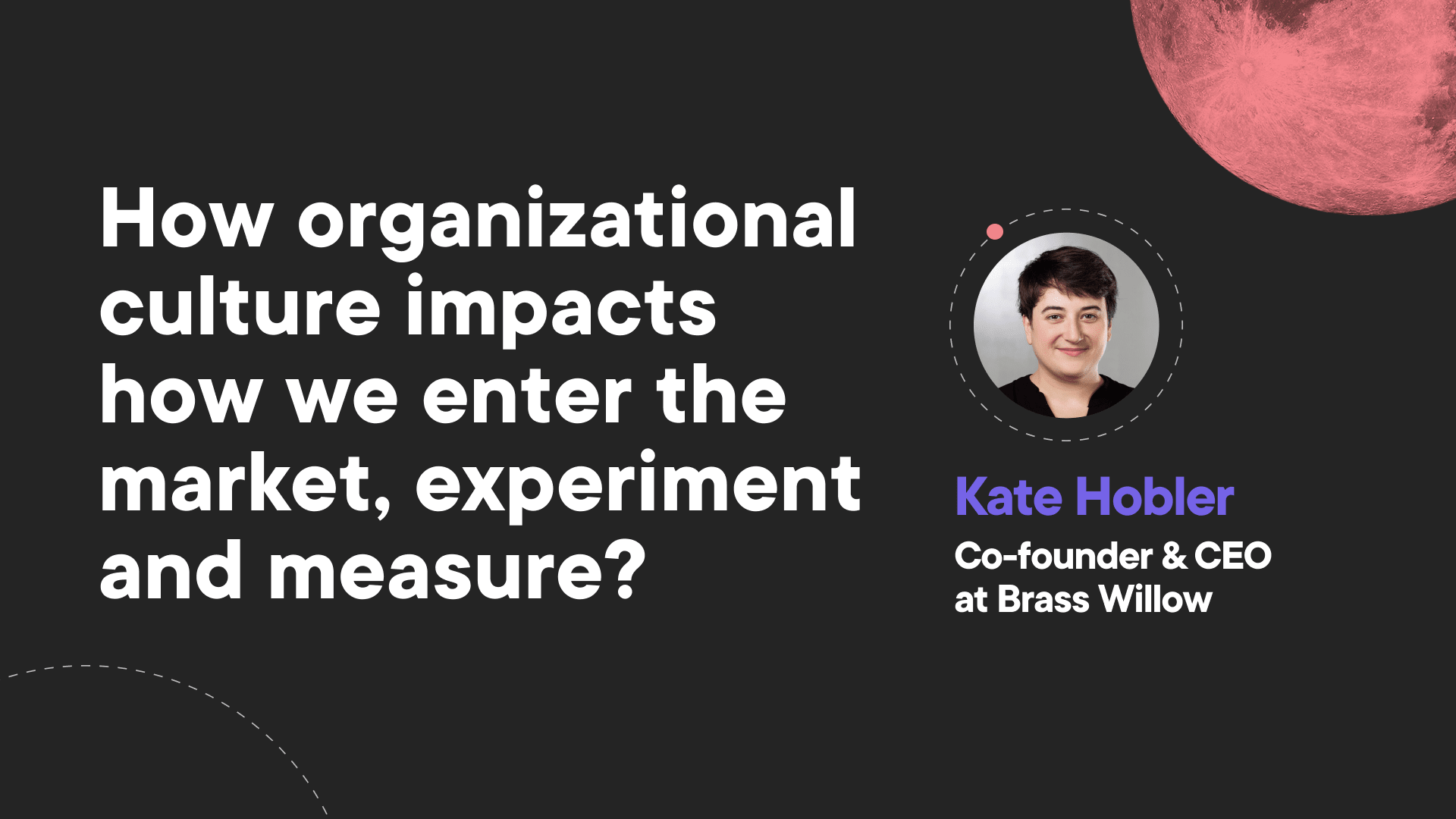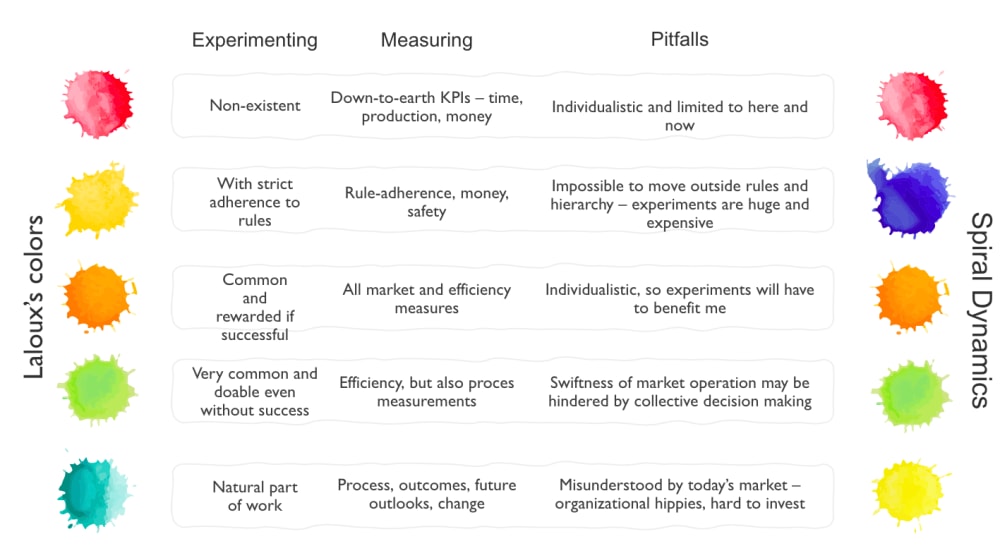Organizational culture and the market
Organizations are like people – they’re all individuals, with different value systems and culture. Whether you’re a startup or a globe-spanning corporation, these differences have a significant impact on how you approach product development, experimentation and measurement. And, ultimately, how you achieve product-market fit. At our recent “Finding Product-Market Fit: Berlin” event, Kate Hobler, Co-Founder & CEO at Brass Willow, explored the question of how organizational culture impacts how we enter the market, experiment and measure. If you think that it doesn’t matter how you run your startup or business, Kate is here to tell you otherwise.

Table of contents
A cautionary tale
Experimentation is an essential part of ensuring a product meets the needs and addresses the pain points of its target users. Kate told the story of working with an anonymous financial institution (let’s call it a bank). Banks don’t tend to be very flexible. New product lead times can run into years – or longer! But this one wanted to be less conservative, wanted to experiment, and was very excited about working on an MVP version of its new product. (Imagine: putting out something that wasn’t a final, polished product in order to gather genuine user feedback and input!)
The reality was that their ‘ready for imminent launch’ minimum viable product consisted of what seemed to be millions of lines of code (and that was just the first part!) and was still 12 months away from a release date. And in the end, the MVP was released late.
So, what happened? Culture happened.
Organizational culture and value systems
The culture of an organization determines its worldview, leadership style and approach to – among many other things – product development and the market. Kate gave an overview of five levels of organizational culture based on Laloux’s color-coded model, as follows:
- Red (power and violence) – This is essentially a jungle worldview, you have to be strong to survive and can only trust yourself. Leadership is accountable but it is also confrontational. Teamwork is not especially valued and the orientation is individualistic. It’s common in organizations that work in the law or are law-adjacent, and also some competitive sales-dominated environments. The problem is that red organizations are often small – only a limited number of people can appreciate the individual.
- Amber (hierarchy) – A yellow organization sees the world as ‘scary’, needing rules and order to make it safe, and can often be seen in traditional corporations and government agencies (and banks – remember the story above?). Leaders represent ‘the law’ and are focused on security of the collective body. The problem is that they feel unjust because status depends on position in the hierarchy and not on ability or experience.
- Orange (capitalism) – Here importance depends on resources, and the individual is responsible for their own success. Leadership is based on results and is challenge-oriented (the ‘rat race’). If this sounds familiar it’s because this is the market in which we all operate, regardless of our specific organizational culture. The problem is, it’s inefficient – teams work much better.
- Green (teamwork) – This is all about building a community, growing together. Leadership is people-oriented and the organization is interconnected. This is Agile. This is Scrum. The problem can be that team-based decision-making – while inclusive – can be slow and/or inefficient.
- Teal (humanism in complex systems) – For most of us, this culture is outside of our experience; it is focused on community but with space for the individual. Leadership is about vision and a teal organization seeks to be both individualistic and collective in how it operates.

One point to notice here is that these cultures are a progression or evolution, each solving the problems of the previous one.
Experimenting as part of product development
Different culture types approach product and idea experiments differently. The bank from Kate’s story could be said to be a combination of red and yellow. The result?
They needed lots of time to feel secure experimenting. The hierarchy prevents rapid or agile testing. An orange organization, with its focus on results, might experiment a lot. But those experiments tend to benefit individuals and not the whole organization (or the customer). You can end up with plenty of impressive test results but never quite reach the stage of launching a full product. Agile green organizations are great at experimenting – the team approach is highly effective but it can be slow. Whereas a teal setup has experimentation baked into the culture – all in service of the vision (in this context: product-market fit).
But what is ‘success’?
Whether an experiment – or a product – is successful depends on how the organization chooses to measure that success. In a way, the metrics used tend to shape elements of the organization’s worldview.
A survival-of-the-fittest red organization is usually focused on traditional KPIs around time, productivity and money. The hierarchical amber also sees money as important but equally emphasis is given to safety and sticking to the rules. Capitalistic orange is focused on market measures but also efficiency, because it has an eye on the future.
Agile green also values efficiency but has evolved to look at processes too – not just a system’s outcomes and results but the system itself is worthy of attention. Teal is the pinnacle of organizational evolution (as we are able to see and predict so far…) and is open to measuring any aspect that contributes to product development, including outcomes, process, future outlooks, even change. This is why failure is often valued – for the important lessons it brings that can be applied to the next stage of the product’s development, and to future products.
Cultural pitfalls
As mentioned above, these organizational culture types represent a form of evolution, each one successfully addressing the flaws of the one before (and also having its own flaws, of course). Red is limited to survival, the here and now. Amber finds it impossible to escape from its own rules and hierarchy. Orange is too individualistic in its approach. Green may fall behind the market because of its need for collective decision-making. And teal’s difficulty is that it has effectively evolved beyond the market and is therefore often misunderstood – which can make it difficult to find investors, who often operate with a more rigid mindset.

What color are you?
Reality is always more complex than any model, and your own organization will show a combination of traits and features from these five possible options. Although, it’s more than likely that if you look at your current approach to product development, experimentation and achieving product-market fit, it will fit into one category more than the others.
But you’re not locked in. You can have the culture – and approach to PMF – that you want. The key is to have values that fit with the way you want to develop your products. So, if you want to change how you experiment and achieve product-market fit, you may need to change your values.
But, as Kate made clear: “It’s up to you what you want to strive for,” and, “When it comes to culture, size does not matter.”
Share this article:






